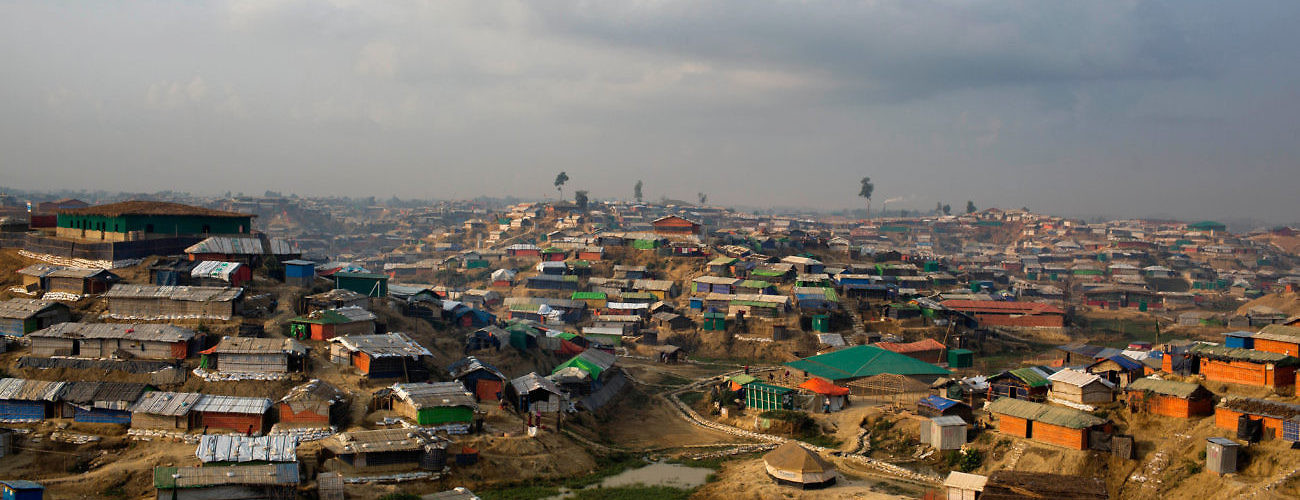A view of the Kutupalong Rohingya refugee camp in the vicinity of Cox's Bazar, southeastern Bangladesh on April 30, 2018. (AP Photo/A.M. Ahad)
The visit at the beginning of May by representatives of the UN Security Council to Cox’s Bazar highlighted the plight of Rohingya refugees in Bangladesh, a growing population with no immediate durable solution, currently supported by a chronically underfunded response. A team from the Global Community Engagement and Resilience Fund (GCERF) also visited several camps and villages hosting refugees just after the Security Council, and were struck by growing tensions across national, ethnic, and religious lines.
There are tensions between Rohingya refugees, especially those inside and outside camps; between refugees and their host communities; and also between the Bangladeshi-majority Muslims and minority Buddhists. A paramount risk is that some or all of these tensions may devolve into violent extremism. Resentment against the socio-economic and environmental impact of refugees is mounting within the host community, and certain groups are promoting hate speech and xenophobia. From the perspective of refugees, some expressed that they are “frustrated, hopeless, traumatized, with nothing left to lose.” There are thus widespread concerns that some refugees may become susceptible to recruitment by terrorist factions, who are rumored to be active in the refugee camps. All these risks will be enhanced if, as most expect, this becomes a more protracted refugee situation.
Given this reality, and without deprioritizing the humanitarian situation, there is a need to focus on the longer-term goal of reducing tensions and building resilience against violent extremism. This, however, is challenging.
GCERF has been active in Cox’s Bazar since before the influx of Rohinyga refugees in August 2017 by providing small grants to local partners for their own initiatives to prevent violent extremism. We are now adapting to the humanitarian context and, in this process, have been able to identify a number of dimensions related to the above challenge.
One dimension is ethical: portraying refugees as potential terrorists is dangerous. Doing so risks fueling hardline views against the refugees in both Myanmar and Bangladesh, especially as both governments try to negotiate a return for the refugees. The evidence globally is quite clear that refugees are rarely responsible for violent extremist or terrorist attacks, but this is not a reason for igoring the risk, especially in pressure cooker situations like Cox’s Bazar.
A second challenge is practical: standard interventions to prevent violent extremism need to be revised and adapted given the reality on the ground. For example, large gatherings have been restricted in Cox’s Bazar, therefore community mobilization events need to be scaled back and more localized.
Another practical challenge has arisen from the presence of humanitarian agencies. While NGOs have created some job opportunities for Bangladeshis and Rohingya, they have also attracted away the trained staff of long-standing local development organizations by offering them much higher salaries. This has had an impact on both the quality and the rate of implementation of programs supported by our grants, as it has it diverted staff recently trained in preventing violent extremism away from local partners.
A third challenge has been created by the shift in priorities among the beneficiaries of our grants. For people in the midst of a humanitarian crisis, the prevention of violent extremism (PVE) is often not a primary concern unless it is combined with the more urgent necessities of food, shelter, sanitation, and health. Refugees who recently attended awareness-raising sessions on PVE were more concerned about access to clean water.
So far, our local partners have tried to respond to these challenges by doubling down on a number of core principles that have guided their PVE interventions.
First, no projects focus exclusively on the refugee population. Just as it is good practice to adopt a community-based approach to refugee assistance, so it should be for PVE.
Second, activities are identified, designed, and led by the populations being served. The drivers of and responses to radicalization to violent extremism are contextual, specific, and dynamic. In the aftermath of the refugee influx, there has been greater demand for awareness-raising on violent extremism, in contrast, for example, to earlier programming which emphasized livelihood support.
Third, ensuring diversity within activities is essential, especially to guard against the false dichotomy that often arises in refugee settings between refugees and hosts, as if these are somehow always distinct and homogenous groups.
Fourth, continually strengthening capacity in order for local partners to recruit, train, and retain dedicated staff is the best way to ensure continuity in PVE efforts, particularly in a rapidly changing context like Cox’s Bazar.
A final consideration, which is bound to arise in efforts to prevent violent extremism in humanitarian settings in general and especially in Cox’s Bazar, is the risk that PVE actors can negatively impact the neutrality, independence, and impartiality of humanitarian efforts. Although there is no clear cut answer to how to respond to this challenge, through GCERF’s approach to grant-making—working through locally-registered NGOs to reach community-based organizations—and its profile as an independent and neutral foundation, we have found that the risk of compromising humanitarian efforts through PVE efforts can be mitigated.
Humanitarian crises often generate conditions that may make violent extremism more likely, i.e., large-scale and uncontrolled population movements, poor governance and security, poverty and disenfranchisement, and people vulnerable to unscrupulous outside influences. PVE interventions are necessary in such settings, but should not undermine the humanitarian response, overwhelm local partners, or stigmatize the populations served. The lessons being learned in Cox’s Bazar can inform best practice for PVE in other humanitarian settings, and can also address the wider conceptual challenge of how to maintain focus on a long-term goal like prevention, in the context of situations with pressing short-term demands.
Khalid Koser is the executive director of the Global Community Engagement and Resilience Fund (GCERF). André Alves Dos Reis is a policy fellow at GCERF. Lilla Schumicky-Logan is a grants officer at GCERF.





